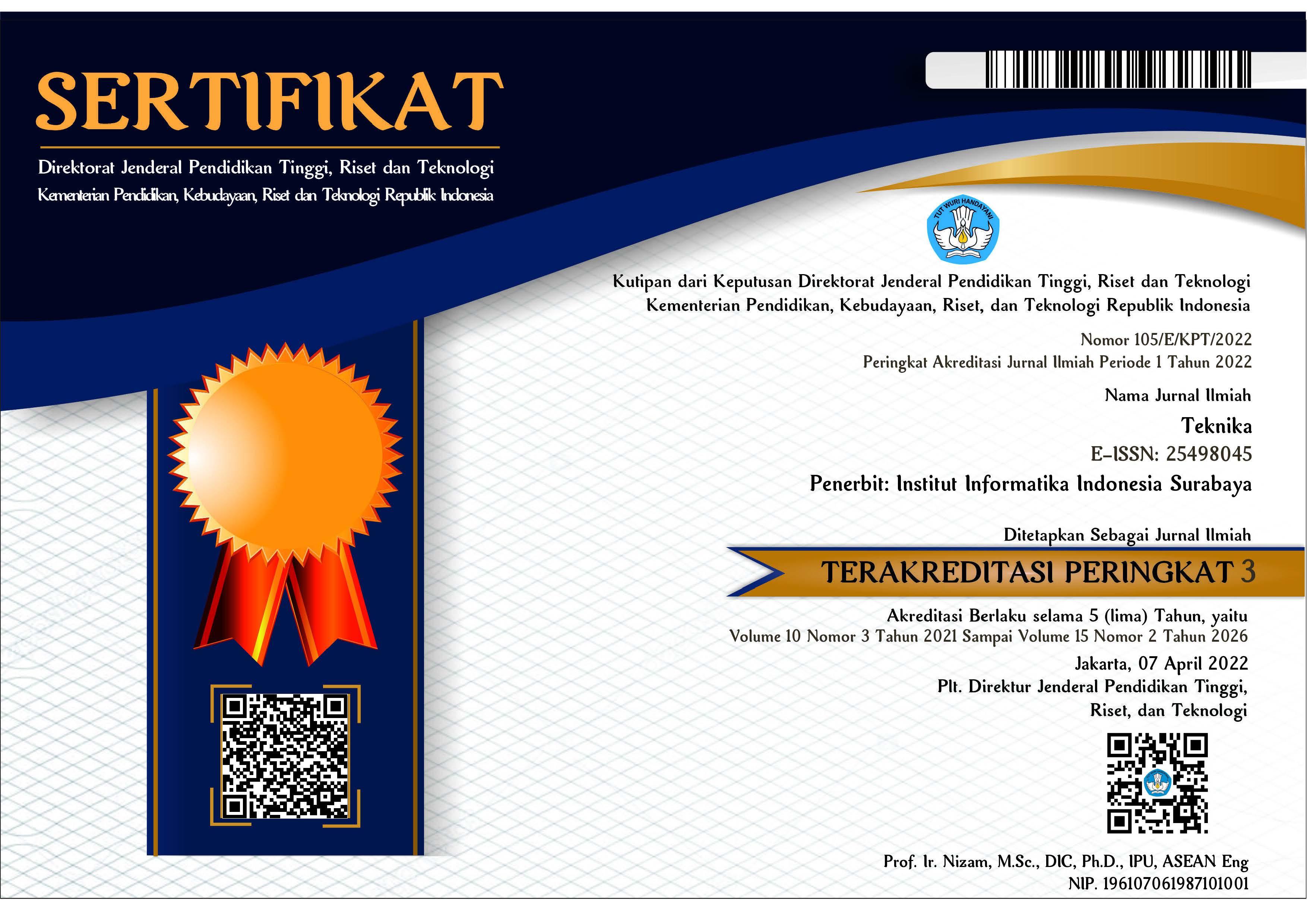Forecasting Model of Export and Import Value of Oil and Gas Using Gated Recurrent Unit Method
DOI:
https://doi.org/10.34148/teknika.v13i2.861Keywords:
Forecasting Model, Oil and Gas Import Export Value, Deep Learning, Gated Recurrent Unit ModelAbstract
Indonesia’s natural resources are abundant, including oil and gas. It is one of the countries active in international trade, including exports and imports. Oil and gas exports are a significant source of income for the country, encouraging economic growth. Oil and gas imports are very important to meet domestic energy needs, which continue to increase in demand. Increasing oil and gas imports can increase the trade balance, which can affect the country’s economic stability if the value of imports exceeds the value of exports. Forecasting is a solution to overcome these problems by forecasting the value of oil and gas exports and imports. The gated recurrent unit (GRU) method is used for forecasting in this study because it has a simple computation and fairly high accuracy. The dataset used is monthly time series data from 1993 to 2023 from the website of the Badan Pusat Statistik (BPS). The MAPE results on the GRU model forecast the value of oil and gas exports and imports at 12.19% and 14.30%, respectively. The best average forecasting of export and import values obtained a MAPE of 13.38%.
Downloads
References
D. Hendarsyah, “E-Commerce Di Era Industri 4.0 Dan Society 5.0,” IQTISHADUNA J. Ilm. Ekon. Kita, vol. 8, no. 2, pp. 171–184, 2019, doi: 10.46367/iqtishaduna.v8i2.170.
D. Kertayuga, E. Santoso, and N. Hidayat, “Prediksi Nilai Ekspor Impor Migas dan Non-Migas Indonesia Menggunakan Extreme Learning Machine (ELM),” J. Pengemb. Teknol. Inf. dan Ilmu Komput., vol. 5, no. 6, pp. 2792–2800, 2021.
S. D. Tubagus, T. O. Rotinsulu, and J. I. Sumual, “Analisis Pengaruh Ekspor Migas, Non Migas, Dan Inflasi Terhadap Pertumbuhan Ekonomi Di Indonesia Periode 2001-2021,” Jur. Ekon. Pembangunan, Fak. Ekon. dan Bisnis Univ. Sam Ratulangi, vol. 23, no. 4, pp. 25–36, 2023.
D. R. N. Salsabila, “Analisis Pengaruh Ekspor Migas dan Non Migas terhadap Pertumbuhan Ekonomi Indonesia,” J. Akunt. dan Manaj., vol. 18, no. 01, pp. 01–08, 2021, doi: 10.36406/jam.v18i01.374.
S. Hodijah and G. P. Angelina, “Analisis Pengaruh Ekspor Dan Impor Terhadap Pertumbuhan Ekonomi Di Indonesia,” J. Manaj. Terap. dan Keuang., vol. 10, no. 01, pp. 53–62, 2021, doi: 10.22437/jmk.v10i01.12512.
P. A. Duran, A. V. Vitianingsih, M. S. Riza, A. L. Maukar, and S. F. A. Wati, “Data Mining Untuk Prediksi Penjualan Menggunakan Metode Simple Linear Regression,” Teknika, vol. 13, no. 1, pp. 27–34, 2024, doi: 10.34148/teknika.v13i1.712.
S. P. Fauzani and D. Rahmi, “Penerapan Metode ARIMA Dalam Peramalan Harga Produksi Karet di Provinsi Riau,” J. Teknol. dan Manaj. Ind. Terap., vol. 2, no. 4, pp. 269–277, 2023, doi: 10.55826/tmit.v2i4.283.
K. Puspita, “Implementasi Metode Trend Projection Dalam Peramalan Persediaan Gas LPG Pada PT. Sintora Putra Gasindo,” J. Manaj. Sist. Inf., vol. 1, no. 2, pp. 65–69, 2023, doi: 10.51920/jurminsi.v1i2.142.
I. Subagja, “Peranan Perusahaan Migas Nasional Terhadap Ketersediaan Energi Indonesia,” JUSTITIABLE, vol. 1, no., pp. 117–130, 2019.
P. N. Yulisa, M. Al Haris, and P. R. Arum, “Peramalan Nilai Ekspor Migas Di Indonesia Menggunakan Model Long Short Term Memory Dan Gated Recurrent Unit Dengan Optimasi Nesterov Adam,” J. Stat., vol. 16, no. 1, pp. 328–341, 2022.
D. Kurniasari, S. Oskavina, W. Wamiliana, and W. Warsono, “Forecasting The Value of Indonesian Oil-Non-Oil and Gas Imported Using The Gated Recurrent Unit (GRU),” Indones. J. Artif. Intell. Data Min., vol. 6, no. 1, p. 71, 2023, doi: 10.24014/ijaidm.v6i1.20651.
A. Suwandi, “Prediksi Harga Emas Menggunakan Metode LSTM dan GRU,” JiTEKH, vol. 8, no. 1, pp. 32–36, 2020, doi: 10.35447/jitekh.v8i1.194.
A. Mahan Zaky, “Forecasting Jumlah Penggunaan Obat Digestive Enzymes dengan Algoritma GRU,” J. Informatics Vocat. Educ., vol. 5, no. 2, pp. 48–55, 2022.
N. W. Saputra, F. Insani, S. Agustian, and S. Sanjaya, “Penerapan Deep Learning Menggunakan Gated Recurrent Unit Untuk Memprediksi Harga Minyak Mentah Dunia,” Build. Informatics, Technol. Sci., vol. 5, no. 1, pp. 86–94, 2023, doi: 10.47065/bits.v5i1.3552.
A. A. Aulia, A. M. Elhanafi, H. Dafitri, A. Aulia, A. M. Elhanafi, and H. Dafitri, “Implementasi Algoritma Gated Recurrent Unit Dalam Melakukan Prediksi Harga Kelapa Sawit Dengan Memanfaatkan Model Recurrent Neural Network ( RNN ),” Pros. SNASTIKOM Semin. Nas. Teknol. Inf. Komun. Pap., pp. 288–294, 2021.
D. Suluh et al., “Peramalan Pertumbuhan Jumlah Outlet Menggunakan Metode Gated Recurrent Unit ( Studi Kasus : PT XYZ ),” J. Comput. Sci. Inf. Syst., vol. 1, pp. 62–72, 2024.
B. N. Azmi, A. Hermawan, and D. Avianto, “Analisis Pengaruh Komposisi Data Training dan Data Testing pada Penggunaan PCA dan Algoritma Decision Tree untuk Klasifikasi Penderita Penyakit Liver,” J. Teknol. Inf. dan Multimed., vol. 4, no. 4, pp. 281–290, 2023.
I. O. Arissinta, I. D. Sulistiyawati, D. Kurnianto, and I. Kharisudin, “Pemodelan Time Series untuk Peramalan Web Traffic,” Prism. Pros. Semin. Nas. Mat., vol. 5, pp. 693–700, 2022.
M. Joseph, Time series forecasting with python. 2022.
S. Prayudani, A. Hizriadi, Y. Y. Lase, Y. Fatmi, and Al-Khowarizmi, “Analysis Accuracy of Forecasting Measurement Technique on Random K-Nearest Neighbor (RKNN) Using MAPE and MSE,” J. Phys. Conf. Ser., vol. 1361, no. 1, 2019, doi: 10.1088/1742-6596/1361/1/012089.























